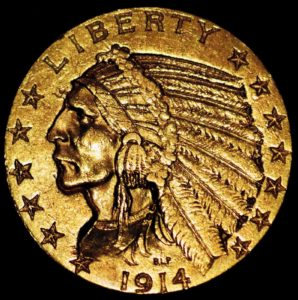Indian Head $5 Gold Half Eagle
Theodore Roosevelt, who served as US president from 1901 to 1909, welcomed new ideas. He was interested in many areas concerning the nation, including coinage design. Roosevelt asked Augustus Saint-Gaudens, the foremost sculptor at the time, to redesign the double eagle and the eagle. The new designs debuted in 1907 to great reviews, and on the heels of that success, Roosevelt sought on redesigning the half eagle and the quarter eagle.
History of the Indian Head $5 Gold Half Eagle
The design of the $5 gold coin had been the same for decades. Other than adding the words IN GOD WE TRUST for the 1866 version, the half eagle remained the same since 1839. It was no surprise then that the arrival of the new Indian Head $5 coin caused some dismay.
Not only was the design very different from what the public was used to; it also featured “sunken design” compared to the usual raised design. The idea of a recessed design came from William Sturgis Bigelow, a physician and art lover from Boston. He was a close friend of Roosevelt and suggested the design idea after seeing an example in Egyptian art at a museum.
Another Bostonian and renowned sculptor, Bela Lyon Pratt, was asked to create new designs for US coins. Pratt’s design depicted a Native American on the obverse with an eagle in the reverse.
A major critic of the new coin design was Samuel H. Chapman, a coin dealer from Philadelphia. He felt the portrait of the American Indian looked emaciated and he believed the sunken design was a health hazard as it attracted dirt and disease.
Despite the protests, the Indian Head coin was produced annually from 1908 to 1916, after which it stopped production for 13 years before resuming for a final bout in 1929.
Production of the Indian Head $5 Gold Half Eagle
The recessed design of the $5 Indian head coin protected it from wear. It was produced annually since it was first introduced in 1908 until 1916. Four different mints produced the coin in 1909, and the mintmarks can be seen on the reverse.
Production of the coin was suspended in 1916 and continued for 13 years. It started being produced again in 1929 at the Philadelphia Mint but halted for good during the Great Depression.
Collecting the Indian Head $5 Gold Half Eagle
With it being the last in the series, the 1929 Indian Head coin is clearly a prized collectible. Although more than 600,000 were produced, many were melted down.
Other than the 1929 half eagle, other notable versions are the 1909 New Orleans. The 1911 Dahlonega, and the 1908 San Francisco.
The coins in this series are well struck with one exception: the mintmarks. The marks are shallow and indistinct, with just a bit of wear rendering them unreadable. The San Francisco Indian Head coins are particularly guilty of this, as are the 1909 New Orleans coins.
No other coin has featured a design similar to the $5 Indian Head, which was used during troubling times in America. But it was also a much valued coin, particularly in 1914 when Henry Ford announced he was raising the pay of his workers to $5 a day.
